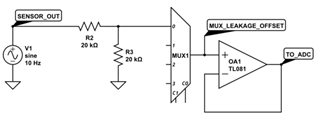Dear community,
I want to build an analog front-end with a 16 channel multiplexer. On each multiplexer input, there will be a voltage divider made from resistors. On the multiplexer output, there will be an op amp buffer and later on a 12-bit ADC. The signals are low frequency (<100Hz). (The schematic below only serves as a rough illustration. Part numbers, resistor value, the source voltage differ)

Now what I'm concerned about is the offset introduced by the multiplexer's leakage current. So for selecting the right part, I will need to make some calculations about the worst-case offset. The application is for an industrial product and I need to consider worst-case value from full temperature range. I already have the correct formulas by hand to calculate the offset. However, what confuses me is the specifications in the datasheet (MUX506):

The datasheet specifies three different leakage currents. I am interested in the leakage that occurs for a particular channel during measurement (when the switch is on). So initially, I though that I just have to consider the Output on-leakage ID(On). Then I noticed that the datasheet uses the term "switch".

